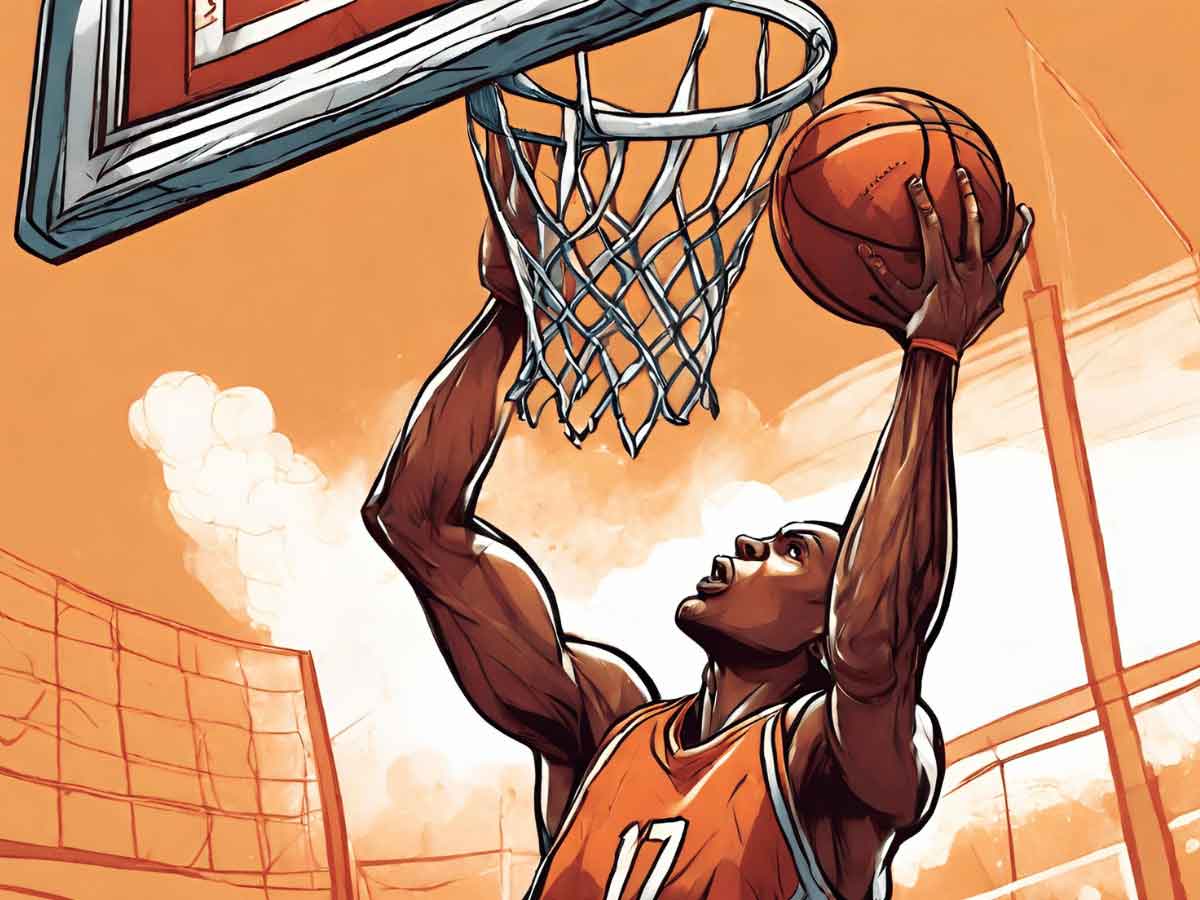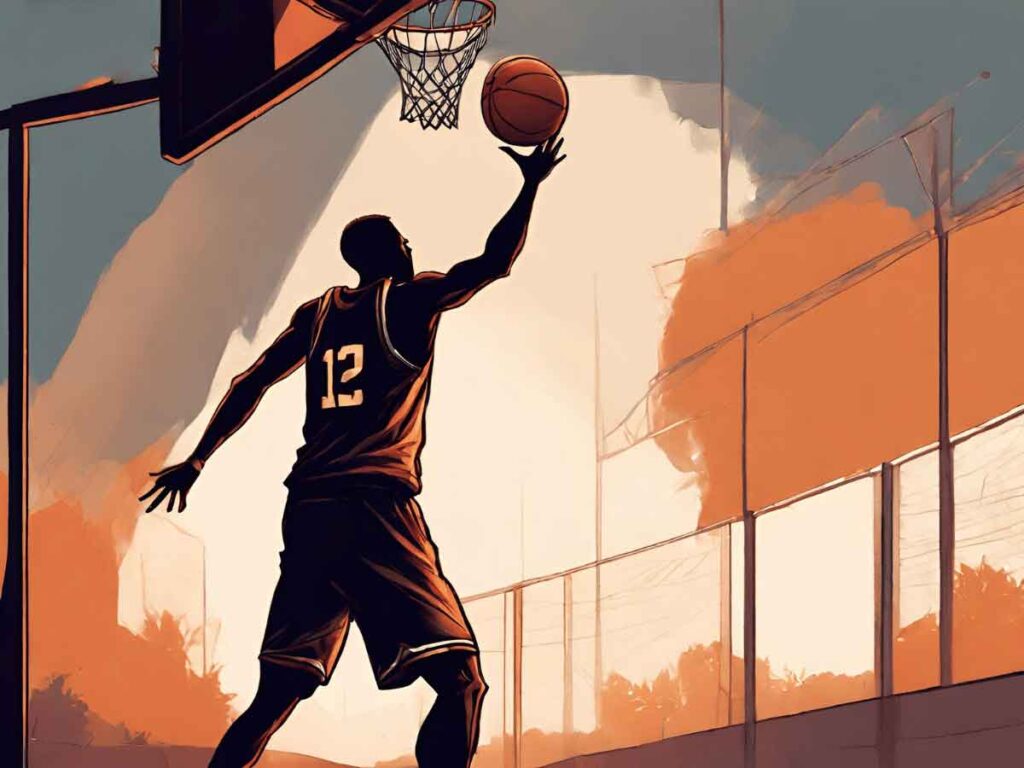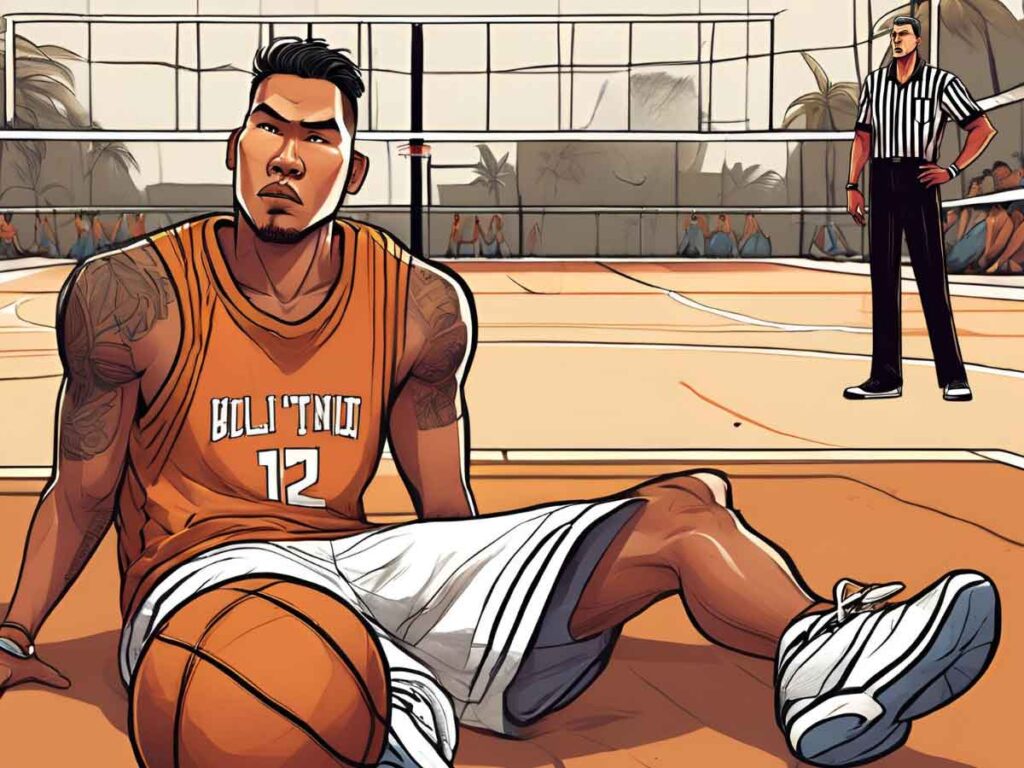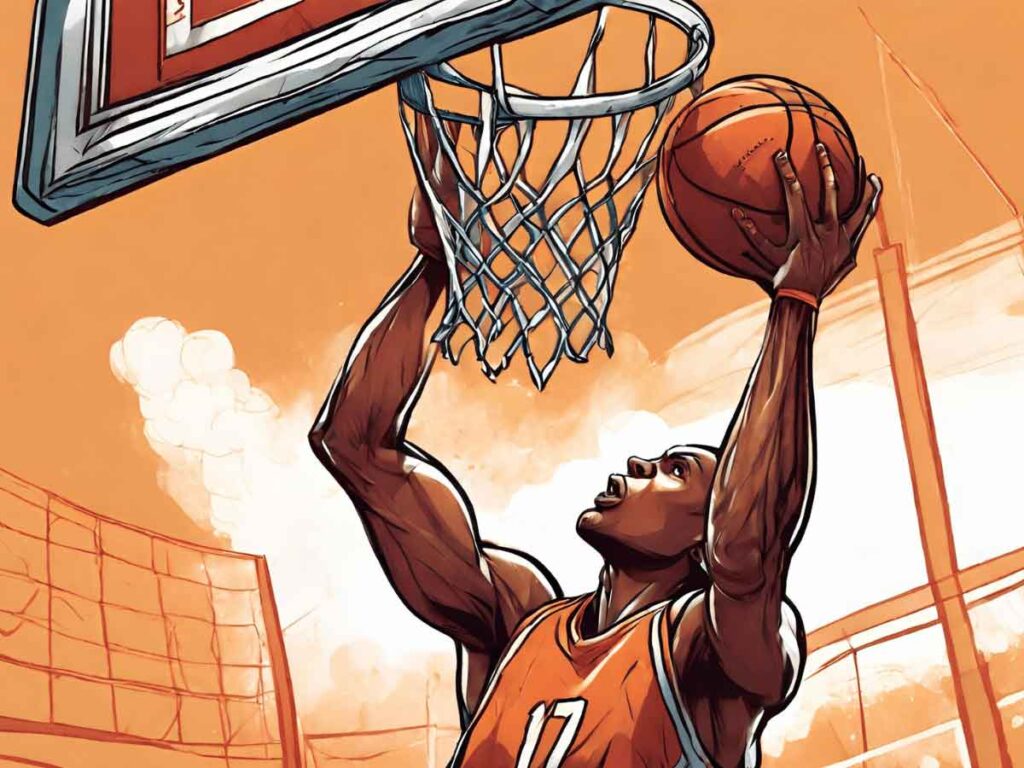“That’s goaltending!” somebody yells. But is it?
Goaltending in basketball is a nuanced and sometimes controversial call. But, it also has a critically important place in the sport because it dictates when a player can and cannot block an opponent’s shot.
If goaltending in basketball didn’t exist, taller defenders could camp out under their opponent’s basket and easily swat away every shot.
So, let’s clarify any confusion you may have about basketball goaltending.
Here are the key takeaways:
- Goaltending is a basketball violation when a player blocks a shot on its downward trajectory or when the ball is over the basket ring.
- The rule started in the NCAA in the mid-1940s as taller players started to jump high enough to reach above the rim.
- Goaltending is similar to, but not the same as, basket interference.
Since its origins in 1944, goaltending has played a big role in defensive rim protection. Stay with me as I break down what goaltending in basketball is, whether the rules vary across leagues, how it impacts the game, and some of the most memorable (or controversial) goaltending moments.
What is the Goaltending Rule in Basketball?
Goaltending in basketball is a specific rule that determines whether a blocked shot is legal or not. If a player is called for goaltending, it means the way they blocked the shot was illegal. As a result, the basket counts.
How Do You Know If It’s Goaltending?
In today’s rules, these four attributes must be met to qualify as goaltending:
- It must be a try for a goal: The offense must have taken a field goal attempt in a legitimate attempt to score. A pass, even an alley-oop pass, can’t lead to a goaltending call.
- The ball must be on its downward flight: The ball has to be moving downward toward the basket when touched.
- The ball must be entirely above the basket ring: When touched, the ball needs to be above ring level.
- It must have a chance to go in: The ball must have a real possibility of entering the basket for the block to be considered goaltending.
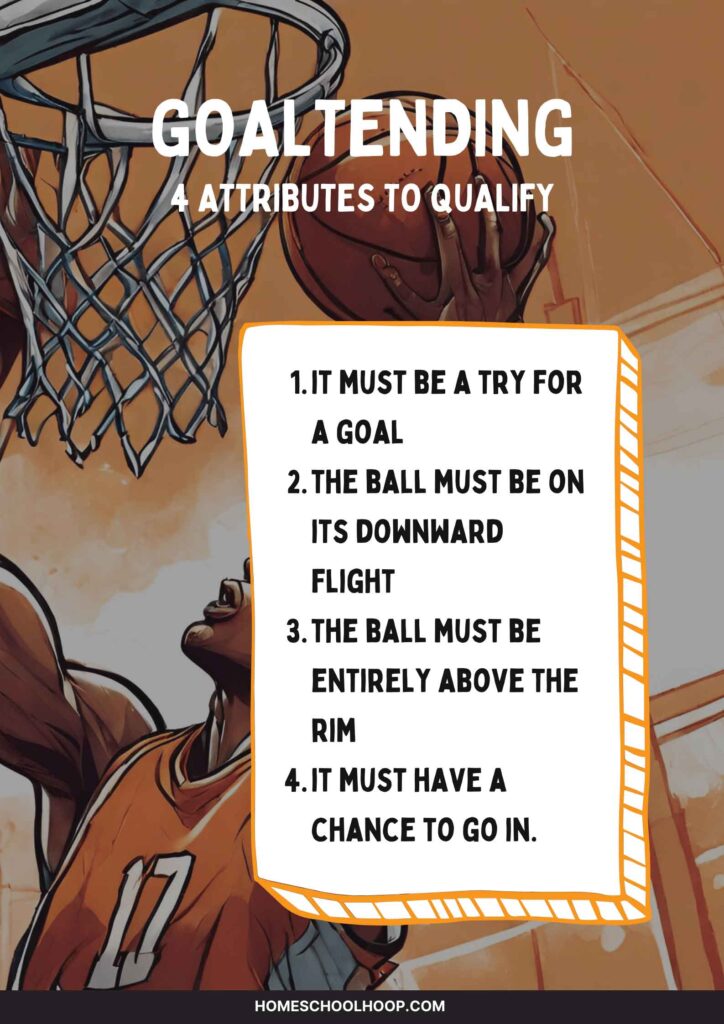
What is the Difference Between Goaltending and Blocking?
Both goaltending and blocking are defensive attempts to deflect away an offensive player’s shot so it doesn’t go in the basket.
How the two differ is legality:
- A block is a legal deflection of a shot attempt because the defender swats away the ball while it’s still on the way up.
- Goaltending is an illegal deflection because the defender swats the ball away while it’s on its downward trajectory.
Remember the 1982 NCAA Men’s Championship game? A young, 7-foot Patrick Ewing tried to block shots but instead racked up five goaltending violations in the opening minutes, giving Michael Jordan’s North Carolina squad 10 points.
Learn more: How tall is a basketball hoop?
Offensive vs. Defensive Goaltending
Yes, goaltending can occur on both the offensive and defensive end. But, offensive goaltending is very rare.
This is because it’s unusual to have all four goaltending attributes met by an offensive player.
What’s the Penalty for Goaltending?
If the defense commits the violation, the offended team automatically gets points as if the shot went in:
- Two points if the shot was taken from the two-point zone
- Three points if taken from the three-point zone
If in the rare case the offense commits the violation, on their own basket, no points are scored. Instead, it’s considered a turnover in basketball. The ball is given to the opposing team out-of-bounds near the spot of the violation.
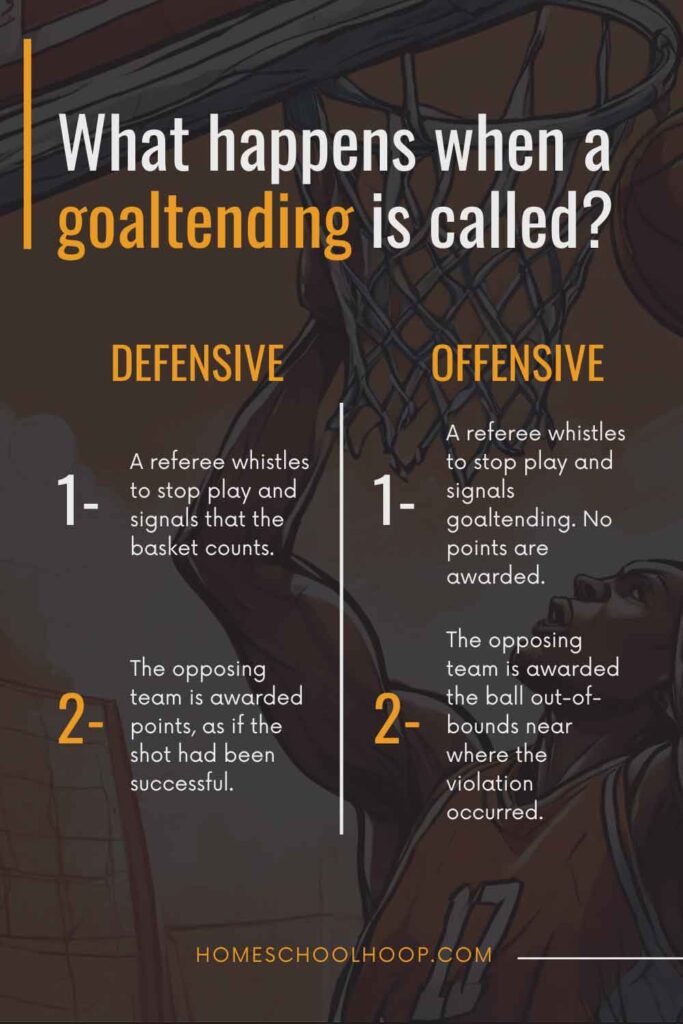
How Goaltending Rules Differ Across Leagues
Goaltending rules are mostly similar across different basketball leagues. But there are a few nuances.
NBA and WNBA:
- In both the NBA and WNBA, a shot that has touched the backboard and is then blocked is always considered goaltending, regardless of whether the ball is still traveling upward. This is most often seen in layup attempts.
NCAA:
- Under the NCAA goaltending rule (both men’s and women’s), goaltending during a free throw results in one point for the shooting team and a technical foul against the player who committed the violation.
- In NCAA men’s basketball, a block attempt is considered goaltending if the ball is on a downward flight toward the rim or if any part of the ball is in the imaginary cylinder above the rim.
- In NCAA women’s basketball, the entire ball must be above the rim level (at least 10 feet off the ground) for it to be goaltending. In the men’s game, it’s enough if just the top of the ball reaches this height.
International Play (FIBA):
- In FIBA competitions, a defender is allowed to legally block a shot when the ball is over the rim but still on its upward flight.
High School:
- Similar to NCAA rules, goaltending during a free throw gives the shooting team an automatic one point. Plus, a technical foul is given to the player who goaltended.
PPG Calculator Tool: What is PPG in Basketball?
Flopping in Basketball Explained: Taking a Close Look at the Controversial Tactic
Understanding Goaltending in Basketball: Rules, Differences, and Famous Controversies
Goaltending vs. Basket Interference
Goaltending and basket interference are often mixed up.
Both involve an illegal blocking attempt and result in the shooting team being awarded points if committed by the defending team.
| GOALTENDING | BASKET INTERFERENCE |
| When a player touches a ball that’s already in a downward flight toward the basket and completely above the level of the rim. | When a player touches the ball or any part of the basket (rim, net, backboard) while the ball is on the rim or within an imaginary cylinder projecting above the rim. Reaching through the basket to touch the ball is also basket interference, regardless of where the ball is. |
| Is about the ball’s trajectory and position relative to the rim when blocked. | Is about illegal contact with the ball or basket when it’s around the rim’s cylinder. |
Dunking is an exception in basket interference. A player can touch the ball in the cylinder during a dunk without it being a violation.
As you can see, these violations are very similar so it’s easy to get confused. Even the NBA rule book and WNBA rule book combine the two under “Basket Interference-Goaltending.”
In fact, the NBA uses goaltending to describe both goaltending and basket interference violations, as you can see in this compilation video below.
The Impact of Goaltending on the Game
Goaltending doesn’t happen all that often in basketball games. But it affects the game in several ways.
Scoring and Points:
- When a defensive player commits goaltending in basketball, the shooting team is awarded the points as if the shot had been successful.
- For the shooter, the goaltender basket counts as a field goal made in the stat book, influencing their PPG.
- These points directly influence the game’s score, which of course, impacts the eventual outcome.
Momentum Shifts:
- A goaltending call can shift the game’s momentum. A team on the verge of a comeback might gain additional motivation from a goaltending call.
Even when goaltending violations don’t happen, the rule still influences each team’s strategy approach to the game.
Strategy Impact:
- Shot blockers have to make sure to get into help position more quickly and to carefully time their block attempts to avoid committing the violation.
- Offensive shooters can get the ball out of their hands faster and adjust the arch of their shots so defenders are more likely not in a position to block their shots legally.
When Did Goaltending Become a Rule?
The goaltending in basketball rule was first introduced in 1944 in the NCAA.
It was a response to the arrival of college players like George Mikan, who were tall and athletic enough to easily block shots at the rim.
It’s hard to imagine today, but before that, players couldn’t get up high enough for basketball goaltending.
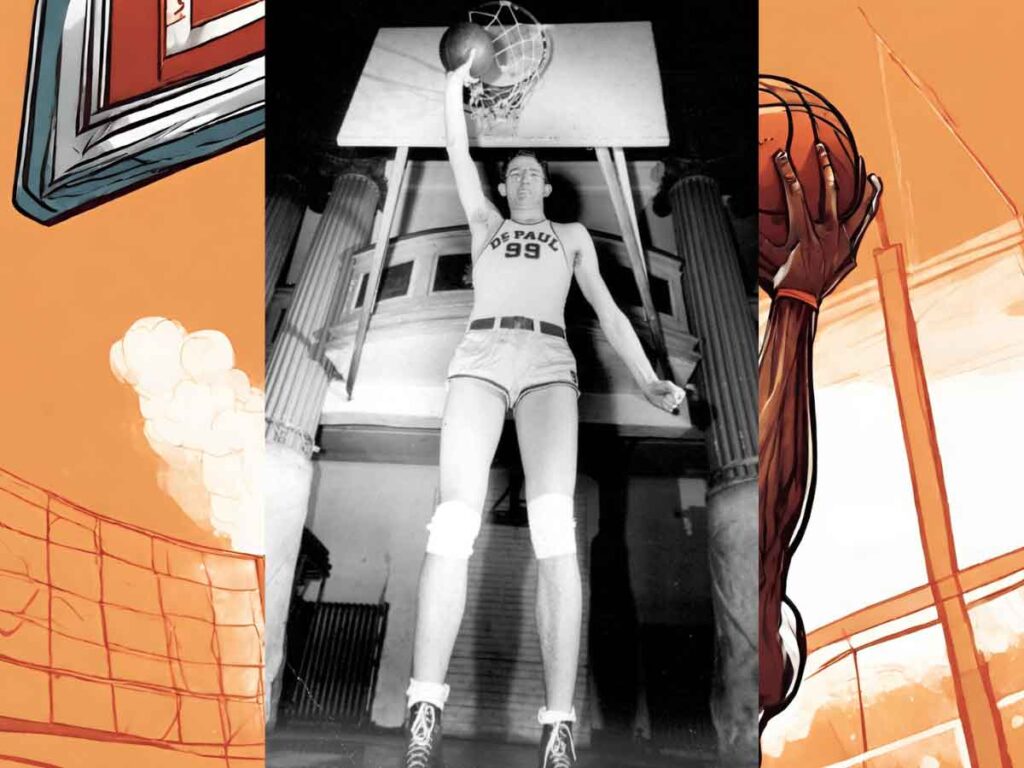
The NBA adopted the defensive goaltending rule early in its history. But when big and dominating players like Bill Russell and Wilt Chamberlain came into the league, the NBA expanded the rule to ban offensive goaltending in 1956. No players could touch the ball if any part of it was over the cylinder.
Today, goaltending and basket interference rules are in place at the professional, college, and high school levels.
Memorable Basketball Goaltending Calls
When goaltending calls do happen, they often stir up controversy. Let’s be fair — sometimes for referees they’re hard to call. The game moves fast. Judging whether the ball is on a downward trajectory and above the rim when it’s touched can be difficult.
And yes, video replay that’s available today helps ref get the calls right more often, but not all calls are reviewed.
So, let’s take a look at some controversial or memorable basketball goaltending calls (or missed calls):
1. Missed Goaltending Call on Damian Lillard’s Layup
In one controversial no-call, referees missed a goaltending violation in the final minute of a close battle between the Portland Trail Blazers and Utah Jazz in 2020.
2. Phantom Goaltending Call on LeBron James’ Block
In the early minutes of a game between the Los Angeles Lakers and Dallas Mavericks, LeBron James elevated so high for a block that the referees mistakenly called it goaltending.
3. Rare Women’s Basketball Goaltending Call on Paige Bueckers’ Layup
You don’t see goaltending called in many women’s basketball games, but in 2024 Miya Crump of Jackson State caught UCONN’s Paige Beckers’ breakaway layup on its way down off the backboard for a violation.
FAQs
Why is goaltending in basketball illegal?
Goaltending is illegal because it gives an unfair advantage to the defense. If it were allowed, shot blockers could stay under the basket and swat away every shot attempt.
Can you goaltend your own team ?
Yes, the offensive team can commit goaltending, but it’s rare. Most often the offense commits basket interference, which happens if they touch the ball above the rim or alter the rim to affect the shot.
What happens if you goaltend a 3-pointer?
If a 3-pointer is goaltended by the defense, the shooting team is awarded three points, just as if the shot had gone in.

If you enjoyed this goaltending basketball article, please share!
